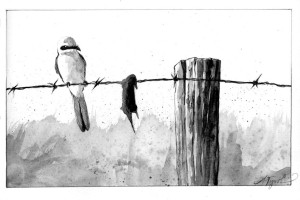
If warblers have nightmares, they are probably about their cousin, the loggerhead shrike (Lanius ludovicianus). An elegant little bird, the shrike’s appearance is not what makes it so fearsome. Its looks could be described as being similar to that of a small, masked, gray robin. Nor is it a particularly prolific or gluttonous hunter – it would likely be as satisfied with a nice, juicy grasshopper as with a mole or warbler. Rather, it is the sheer ferocity of this unassuming bird’s attack that makes it the likely subject of passerine terror.
The loggerhead sights its prey by perching, hawklike, atop a favorite bush or fence post. If the quarry happens to be another bird, the two engage in a high-speed aerial chase, finishing with a characteristic swoop and flutter in which the loggerhead seizes its victim in its poorly adapted, perching grasp. Lacking the grasping talons or the tearing beak of its competitors, the eagle and the hawk, the loggerhead does what it can. Still holding the prey in its grasp, the shrike beats it about the head with its stout, blunt bill, rendering it unconscious. A veritable ornithological Vlad the Impaler, it finishes the kill by impaling its victim on a nearby thorn bush or barbed-wire fence, often beside the corpses of past victims.
Quite a feat, for a songbird.
There are a number of interesting reasons for the loggerhead’s unusual hunting methods and macabre collections. As mentioned, it is not well adapted to hunting other birds. As a member of the songbird family, its slight feet are better equipped for perching than for grasping, and its blunt beak is not well suited to the ripping and tearing of flesh. The thorn or barb holding the impaled prey helps to compensate for this inadequacy, helping both to hold the meal in place and to facilitate its consumption.
Additionally, the collection of carcasses acts as a cache created in times of plenty to be consumed when the shrike is more vulnerable. Researchers have observed female loggerheads feeding their young from the supply of food held in store near their nests. The male of the species, on the other hand, may use the excess to advertise his fitness and prowess as a hunter during mating season, or to define or mark his territory. Or perhaps the loggerhead simply enjoys the appearance of a series of victims artfully arranged on a thorn bush – like baubles on a Christmas tree.
One thing that is certain about the loggerhead is that its numbers are declining, especially in the Northeast, and nobody is quite sure why. One theory is that, with changes in land use in recent years, much of the shrubby habitat preferred by the shrike is being lost, and in fact the shrike is considered an important indicator species for that type of habitat. But there is more to the story than just that.
It seems that in its wintering grounds, especially, the “swoop” part of the shrike’s attack can get it into trouble. Often, the shrike’s prey – and therefore, the shrike itself – is drawn to the warmth of pavement. When the shrike swoops in for the catch, it will often meet with the unfriendly end of a passing automobile. Other possible culprits include poisoning by accumulation of pesticides in the food chain and a lack of suitable wintering habitat. As the shrike has a high nesting success rate compared to other birds, its prospects for repopulation are excellent if the cause of the decline can be identified and remedied.
Once fairly common throughout most of North America, the loggerhead’s decline began in the 1930s. Documentation of the downward population trend became possible with the inception of the North American Breeding Bird Survey in 1966, just as loggerhead populations began to plummet. Since that date, the population has dropped by 55 percent range-wide, and as much as 88 percent in the Northeast, placing it on the endangered species lists of both Vermont and New Hampshire. Despite recent efforts at rehabilitation, shrike numbers continue to decline, with additional losses estimated at 3.2 percent per year nationally and 5.5 percent per year in the Northeast.
Of further concern, in addition to the general population decline, is the shrinking breeding range of the loggerhead. Its breeding grounds once stretched from southern Canada to Virginia, and as far east as Maine. Now completely extirpated from Maine and most of New Hampshire, it is seldom seen as a breeder farther north than Pennsylvania, except for in a few isolated pockets of northern New York and Vermont.
Management efforts for the loggerhead shrike continue, and it is strongly recommended that any shrike sightings be reported to local conservation authorities. Clearly, much remains to be learned about this useful and fascinating bird.

